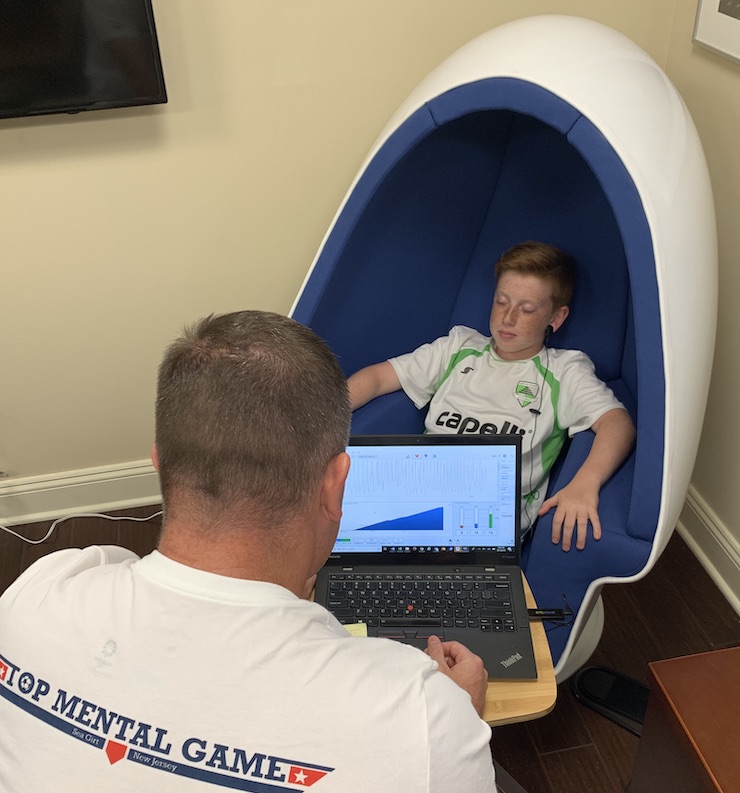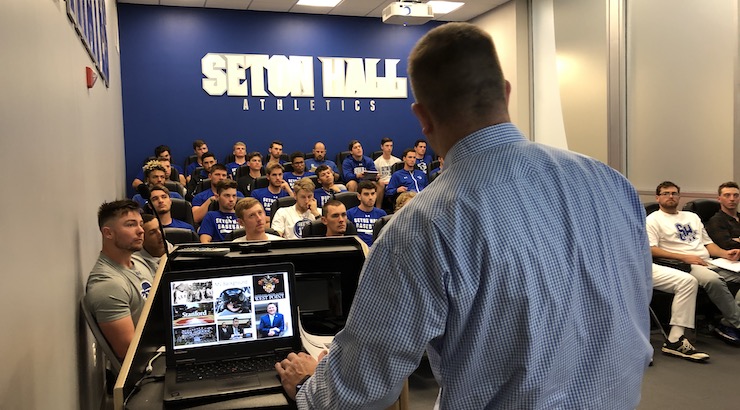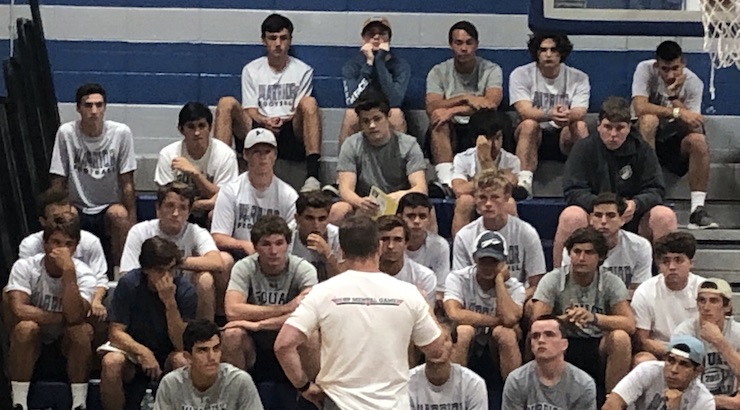Help! I’m a Coach and Want to Teach the Mental Game – Part II
If you’re a soccer coach, chances are you religiously keep up with the latest drills and methods to improve the technical and tactical aspects of your team.
You want to know the latest trends in strategy, formations, and styles of play to stay one step ahead of the competition on the pitch. And, even though U.S. Soccer agrees that the psychological component is the 4th pillar of player development, there are very few quality resources for coaches and players.

Read: TEACHING THE MENTAL SIDE OF YOUTH SOCCER
In an article published last year on how the U.S. Women’s National Team was developing their mental game, the author discussed the important gap between recognizing mental strength training is important and providing the tools need to close this gap:
Most soccer coaches say ‘yes,’ mental training is important but when asked if they actually provide any … the answer is almost always ‘no.’
But don’t panic. Soccer Today has you covered with a series of articles for coaches looking to improve the mental toughness of their teams.
In Part I on Teaching the Mental Side of the Game, I discussed the mind-body connection, shared tips on where to start, and suggested how coaches get buy-in from their teams on the mental game.
Here in Part II, I provide five activities that every coach should have in their mental game toolkit.
In Part III, the last in the series on Teaching the Mental Side of the Game, I give coaches an introduction to visualization and pre-competition routines that are guaranteed to get your team playing at their best when it matters the most.

So Where Do I Begin?
Pre-season Soccer Activities
The next two activities are guaranteed to arm your team with the proper mindset. The first is a team exercise and the second is an individual exercise. Don’t worry, however, if your season has already started. Both activities are great to do anytime, whether on a day where you know you’re going to get weathered out or perhaps have a tournament cancelled due to the COVID crisis.
Read: HELPING YOUTH SOCCER PLAYERS BUILD CONFIDENCE AFTER COVID
Soccer Team Values, Behaviors, Norms, and Culture
Senior leaders in every field often grumble that younger generations are different and that they don’t behave like previous generations. Soccer coaches are no different and equally as likely to gripe that “they don’t make ‘em like they used to.”
But the most effective coaches know they must adapt. So how can coaches get their teams to think and act like champions?
Simple. Familiarize your players on how champions act.
Then hold them accountable. Better yet, create a culture where teammates, not just coaches, hold everyone accountable.

Read: MAKING THESE DAYS COUNT: SOCCER STAR JULIE FOUDY ON WHY MENTAL SKILLS COUNT and MAKING THESE COVID-19 DAYS COUNT WITH BRYAN PRICE & JULIE FOUDY
When I work with teams, particularly in the pre-season, I love doing a exercise on values, behaviors, and norms. All coaches want a great culture. Here’s one way to create one.
- Ask your team to describe what values they want to be known for this year. I like to come up with between 5 and 7 values, things like being mentally tough, hard-working, positive, fun, resilient, relentless, and selfless.
- Once you and your players have settled on a list, ask them what behaviors are associated with each team value. In other words, what do those values “look like” in terms of behavior on the pitch?
- Values become norms when those associated behaviors are scrutinized, appreciated, and celebrated. In the Army, we used to say “inspect what you expect.” A lot of teams talk about values, but unless coaches and teammates hold each other accountable for the behaviors that back up these values, it is just talk.
Here’s an example. Say your squad identifies resilience as the desired team value.
What does resilience look like on the pitch? What behaviors are associated with resilience?
Your team might say resilience starts with the right body language, speaking positive words of encouragement, and picking up teammates after they’ve made a mistake – behaviors like running back to the restart after conceding a goal, keeping your head up, shoulders back, and motivating your teammates to do the same.

Because the team, not just the coach, come up with these values and behaviors in this exercise, players will feel as though they have more buy-in. As a result, they’ll be more likely to hold themselves and each other accountable. When this happens, behaviors become team norms, and those norms help create a team culture.
Instead of being coach-led, this method allows the culture to become player-led. Coach-led teams can be good, but they’re unlikely to ever be great. Player-led teams, however, can become legendary.
Goal-Setting for Soccer Players
Goal-setting is another great pre-season exercise to get players in the right mindset.
Ask most players what their goals are, and chances are they will respond with some type of outcome goal, like earning a starting spot, scoring a certain number of goals, or winning a championship. Outcome goals are great, but they are often about results that depend on a variety of factors, many of which are beyond a player’s direct control.
For example, many teenage players may say their goal is to earn a scholarship to play at the Division-I level. It’s a fantastic goal, but there are so many factors that are outside a player’s control.
Players don’t make out the lineup card, determine what formation their team uses, or schedule opponents. Nor do they sit on the admissions committee of the college of their choice, or make decisions about who gets what scholarship money on a college team.
What players do control, however, is their process.
Ask players to name the things they can control that will maximize their chances of achieving their outcome goal. Better yet, ask players what actions they can take today that will maximize their chances of achieving their outcome goal.
They’ll come up with things like effort, attitude, conditioning, foot skills, sleep, work ethic, nutrition, and (hopefully!) their mental game.

Generation Z players want to be empowered rather than being told what to do. And players today also prefer to be told why they’re doing something. Coaches may not like or understand these preferences, but they’re a reality. And activities like this and the values exercise mentioned above are great ways to get buy-in and ultimately elite-level performance from this generation of players.
Once players have identified their goals (outcome and process goals), I tell them to print them out and put them everywhere they’ll see it – on their bedroom ceiling, on their bathroom mirror, on the fridge, and of course, on their phone, especially on their home screen. The more they see it, the more they’re reminded of what’s important and why they’re doing it.
Mental Huddles Before Soccer Practices
One of the common excuses coaches make for not working on the mental game with their team is that they just don’t have time.
But coaches can improve the mental toughness of their teams in as little as 10 minutes a day. Even if coaches don’t want to use the on-the-field time to work on the mental game, surely they can make a plan to talk about mental skills during the numerous practices canceled due to weather (not to mention practices and tournaments nixed due to the COVID-19 crisis).
The following activities can all be done in 10 minutes or less and are guaranteed to get your team on the right path to mental toughness. (Coaches should feel free to reach out to me for more exercises).

Control The Controllables Exercise
In a previous Soccer Today article, I discussed the importance of controlling the controllables. The game of soccer requires tremendous focus and cognitive awareness to play at a high level. Wasting energy, time, and focus on things we can’t control can only distract us from the task at hand.
This exercise is most effective when you don’t tell your team that it’s about controlling the controllables.
Instead, simply ask them to list the many variables that influence which team wins or loses any particular game. Write their answers down (best if done on a whiteboard that they can all see), but as you do so, separate their answers into two unlabeled columns. Under one column, list their answers about things they can control, and in the other, list things they can’t control.
For example, things like the talent level of the opposing team, the playing surface (turf/grass), weather conditions, and the quality of the refereeing would go in the “uncontrollable” column.
In the “controllable” column, you’d put things like your team’s effort, attitude, hustle, communication, conditioning, and mental toughness. This is also where you’d put answers that relate to your player’s personal preparation – things like rest, recovery, and nutrition.
It’s imperative, however, that you don’t label the columns nor explain why you’re putting their answers into two separate columns.
After they’ve finished answering, ask if anybody recognizes the pattern. When they do, tell them to remember this exercise during games when players want to complain about things that are beyond their control.
When players and coaches slip up during a match, anyone should feel comfortable with a simple, but effective, reminder. “C’mon, let’s go. Control the controllables.”

In Soccer, Reset Ritual
We’ve all watched a game where a player makes an early mistake and is never the same afterward. Perhaps that mistake is a crucial turnover that leads to a goal or a blown scoring opportunity on an easy tap-in, but regardless, that player never recovers.
They let one bad play ruin their entire performance, either because they’re still busy beating themselves up over it or because they’re now playing small, scared, and terrified of making another mistake.
Coaches can teach their players a reset ritual that can help them turn the page, recover, and get back to playing at their best. Think of it like hitting one’s personal reset button or control-alt-delete on your computer.
To empower your players and obtain their buy-in to their mental game (are you noticing a trend here!), have them create a personal reset ritual that includes a physical act, a reset word or phrase, and a deep, cleansing breath.
The physical act can be anything, but it should be personalized to the player. I’ve had players who would clap twice, tap their chest, readjust their socks a certain way, or simulate rubbing the dirt off their shoulder.
When U.S. soccer legend Julie Foudy made a mistake, she would snap a hairband she wore on her wrist.
The reset word or phrase should be short, positive, and meaningful to the player. I’ve had players who say “let’s go,” “clear it, “you got this,” “next play,” or “chill.” Julie Foudy’s reset phrase was “Snap out of it.” I’ve even had a player whose reset word was “lefty.” Now “lefty” doesn’t mean anything to me, but it did for my athlete, and anything that is meaningful to the athlete and gets them present in the moment is what you want.
Finally, have your players complete their reset ritual with a deep cleansing breath. I tell them to visualize inhaling positivity and exhaling negativity and all the garbage surrounding their last play. Once they breathe out, it’s time to move on to the next play.
The beautiful part is that this simple act takes only a second or two to perform, and yet it can literally change a player’s mentality, focus, and ultimately their performance for the rest of the game.
Once the whole team understands this concept, they can help police each other. If they see teammates make a mistake and then start hanging their heads or pouting, a simple reminder is all that’s needed. “Hey man, reset.”
One crucial point to note, however, is that this reset ritual has to be performed in practice. If players don’t do it in practice, it won’t become second nature to perform the ritual during games.
And coaches, this is also a useful exercise for you so you don’t let a poor coaching decision negatively impact your mindset the rest of the match.

Self-talk Exercise in Soccer
Every coach appreciates the important role that communication plays in the game of soccer. This includes communication between coaches and players and between players themselves.
But the person we communicate the most with is ourselves. And what we say to ourselves has the most impact on our performance.
Researchers have shown that we are hard-wired to be negative, especially when we engage in activities that are outside of our comfort zone. It’s an evolutionary feature that helps keep us safe and alive. But it’s not a great recipe for extraordinary performance.
We all have inherent beliefs about our game, and whether you’re conscious of them or not, we have all said negative things to ourselves in competition. Do any of these sound familiar?
- “I’ve never been good with my left foot.”
- “I always let my team down in pressure situations.”
- “I’ve never been good at headers.”
- “I’m too slow.”
- “I choke in big moments.”
- “I’m not good enough.”
- “I don’t deserve to be here.”
A great 10-minute exercise to do with your team is to have them come prepared to share the two or three worst things they say to themselves in competition. Then pair off teammates and have them share these two or three hurtful things with each other, except instruct them to switch from the 1st-person (e.g. “I stink”) to the 2nd-person (e.g. “You stink”) as though they are admonishing their teammate about how awful they are.
After each teammate has had an opportunity to go, bring the team together, and ask how it felt to tell their teammates these horrible things. You’ll likely hear that players felt awkward saying such harsh things to their brothers and sisters. When pressed as to why, they’ll likely say that they would never tell them those things in “real life.”
This is the coach’s opportunity to drive home the “aha” point of this exercise.
If players found it difficult to say such negative things to their teammates, then what does it say about the impact that saying these very things to ourselves has on our personal performance? Why are we self-sabotaging our play?
Negative self-talk unequivocally hurts performance.
To fix this, the first step is becoming self-aware about our own negative self-talk.
While we can never fully remove negative self-talk from our thinking, it’s possible to identify when we’re going negative and immediately replace that negative thought with something positive and motivating.
A Final Word
This article featured five simple exercises coaches can do to give their teams a leg up on the competition.
Coaches who invest in the mental game and adapt to this generation of players will be more successful than those who don’t. In just ten minutes per practice, or taking advantage of downtime due to weather or COVID cancellations, coaches can easily increase their team’s mental toughness and create a culture of excellence that will no doubt pay dividends on the pitch.
Up Next: Part III: Pre-competition routines for coaches to maximize the performance of your teams.





